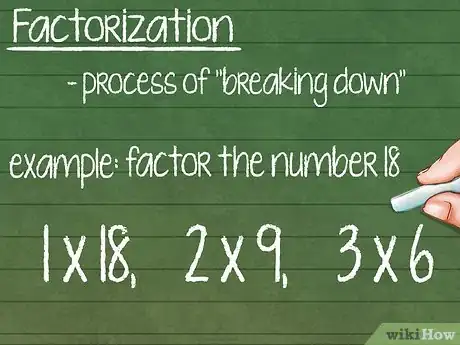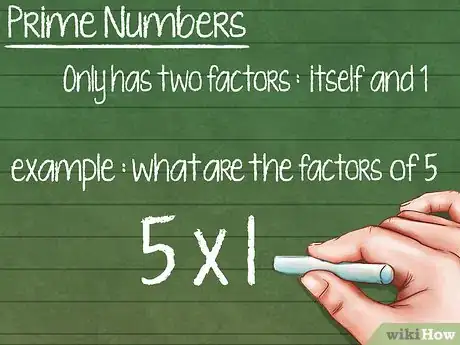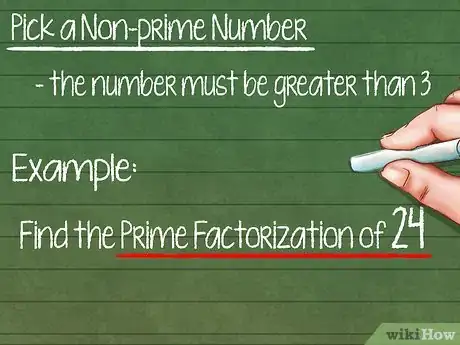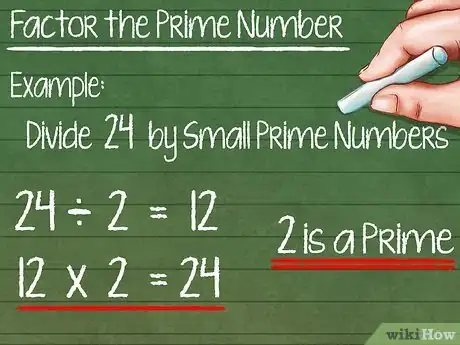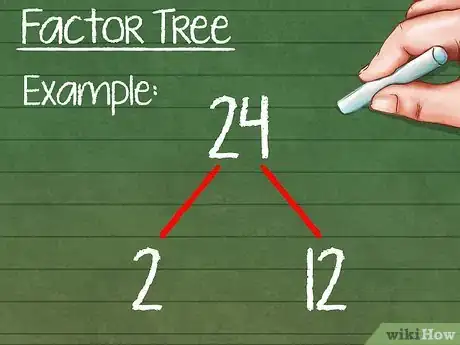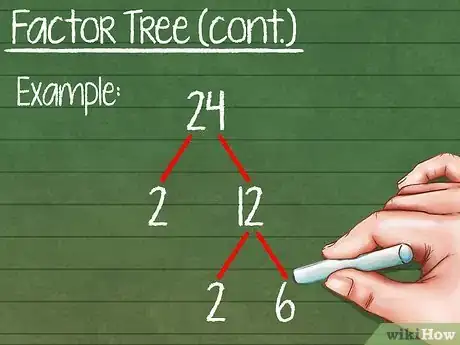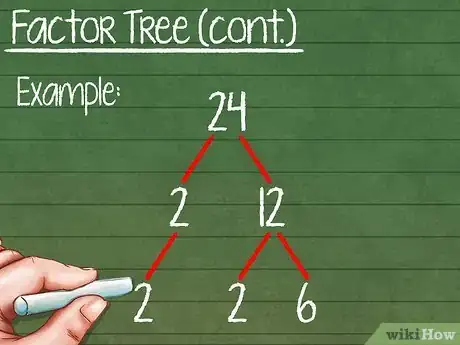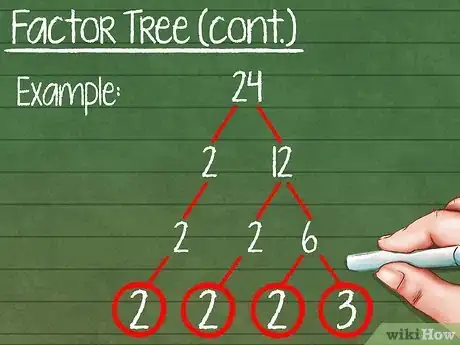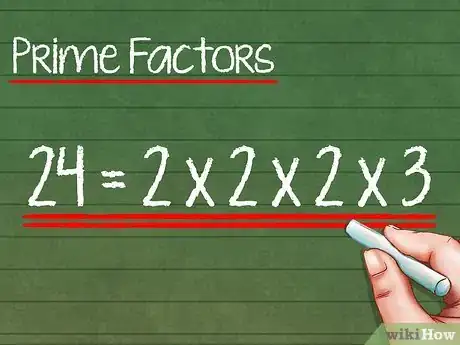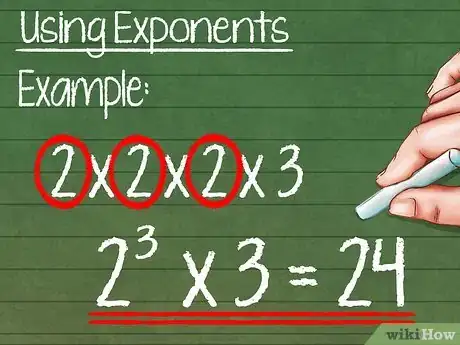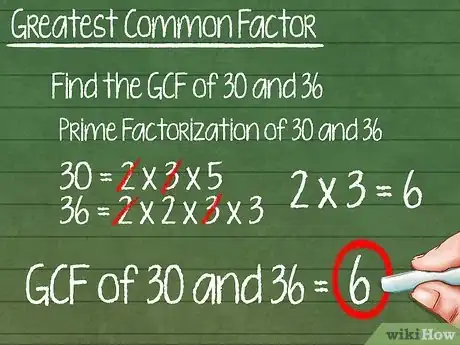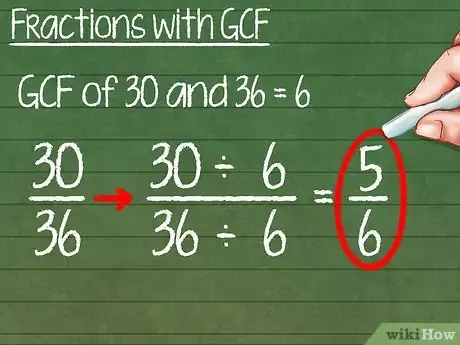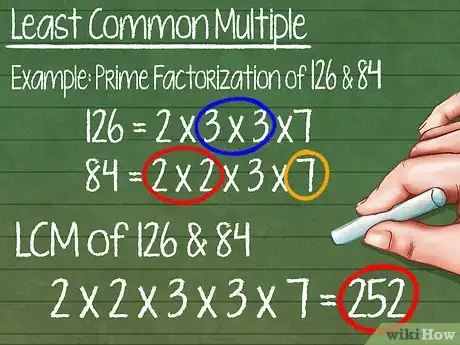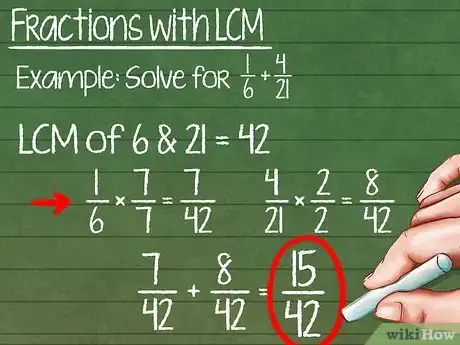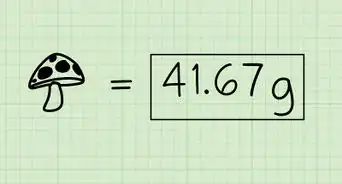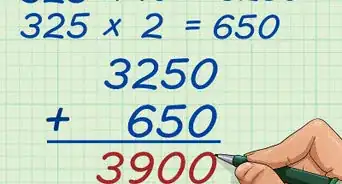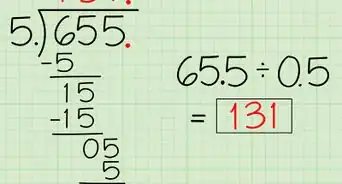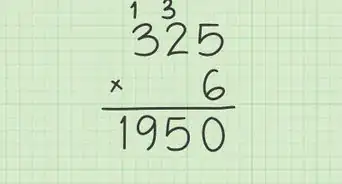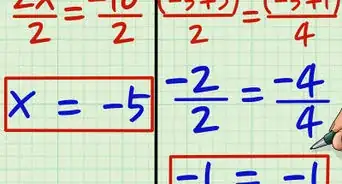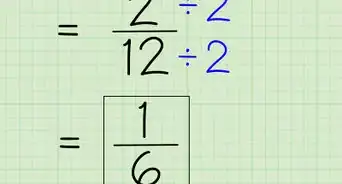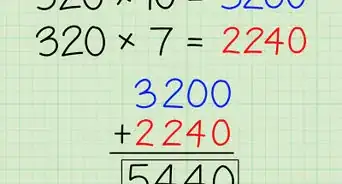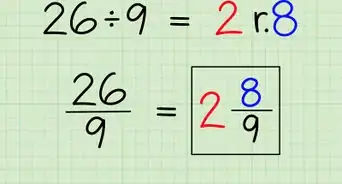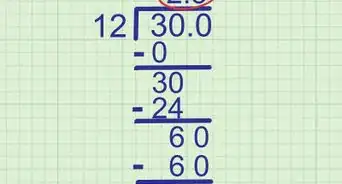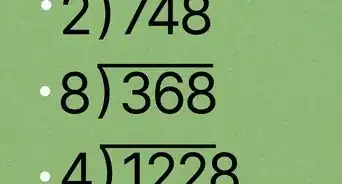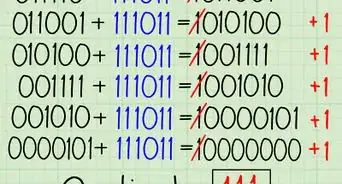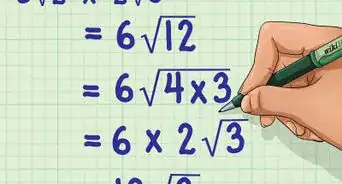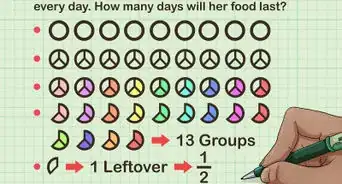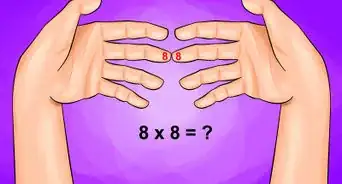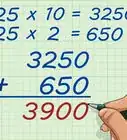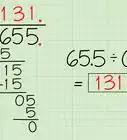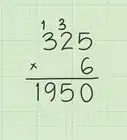wikiHow is a “wiki,” similar to Wikipedia, which means that many of our articles are co-written by multiple authors. To create this article, 15 people, some anonymous, worked to edit and improve it over time.
There are 9 references cited in this article, which can be found at the bottom of the page.
This article has been viewed 59,999 times.
Learn more...
Prime factorization breaks a number down into its simplest building blocks. If you hate working with large numbers like 5,733, learn how to turn it into 3 x 3 x 7 x 7 x 13 instead. This type of problem is vital to cryptography, or the techniques used to keep information secure. If you're not ready to create your own secure email system yet, try using prime factorization to make fractions easier instead.
Steps
Finding Prime Factorization
-
1Understand factorization. Factorization is the process of "breaking down" a number into smaller parts. These parts, or factors, multiply with each other to equal the original number.[1]
- For example, to factor the number 18, break it into 1 x 18, or into 2 x 9, or into 3 x 6.
-
2Review prime numbers. A prime number only has two factors: itself and 1. The number 5, for example, is the product of 5 and 1. You can't break it down into any other numbers. The goal of prime factorization is to keep breaking a number down until there are only primes left. This is especially useful when handling fractions, making them easier to compare and use in equations.[2]Advertisement
-
3Start with a number. Pick any non-prime number greater than 3. There's no point starting with a prime number, since there's no way to factor it.[3]
- Example: In this guide, we'll find the prime factorization of 24.
-
4Factor it into any two numbers. Find any two numbers that multiply together to make the number you started with. You can use any two you can think of, but a prime number will make your work easier. One good strategy is to try dividing the number by 2, then 3, then 5, working your way up through the prime numbers until you find one that divides evenly.[4]
- Example: If you don't know any factors of 24, try dividing it by small prime numbers. Let's divide by 2 to get 24 = 2 x 12. We're not done yet, but this is a good start.
- Since 2 is prime, this is an easy way to start when factoring any even number.
-
5Start making a factor tree. A factor tree is an easy way to keep track of a factorization problem. To start one, just draw two "branches" splitting down from the original number. Write your two factors at the end of these branches.[5]
- Example:
- 24
- /\
- 2 12
-
6Factor the next line of numbers. Look at your two new numbers (the second line on your factor tree). Are they both primes? If one of them isn't a prime, factor it again the same way. Draw more branches on the tree and write the new factors on a third line.
- Example: 12 is not a prime, so we factor it again. Let's use 12 = 2 x 6 and add it to the factor tree:
- 24
- /\
- 2 12
- /\
- 2 x 6
-
7Bring down prime. If one of the factors is prime, bring it down onto the next line with its own single "branch." There's no way to break it down further, so we're just keeping track of it for now.
- Example: 2 is a prime number. Bring the 2 from the second line down to the third.
- 24
- /\
- 2 12
- / /\
- 2 2 6
-
8Keep factoring until you're left with only primes. Check each new row on the factor tree once you write it. If any of the numbers can be factored again, make a new row. You're finished once there are only prime numbers left.[6]
- Example: 6 is a non-prime number and needs to be factored again. 2 is a prime number, so we just bring the 2s down to the next row.
- 24
- /\
- 2 12
- / /\
- 2 2 6
- / / /\
- 2 2 2 3
-
9Write the final line as your prime factors. Eventually, you'll only have prime numbers left. When this happens, you're done factoring. The prime factorization is the entire, last line of numbers, written as a multiplication problem.[7]
- Check your work by multiplying the last line together. It should equal the original number.
- Example: The final line of our factor tree has nothing but 2s and 3s. These are both primes, so we're finished. We can write the prime factorization of 24 as 24 = 2 x 2 x 2 x 3.
- The order of the factors does not matter. 2 x 3 x 2 x 2 is also a correct answer.
-
10Simplify using exponents (optional). If you know how to write exponents, you can make the prime factorization easier to read. Remember, an exponent is a base number, followed by a raised number that states how many times the base is multiplied.
- Example: In the factorization 2 x 2 x 2 x 3, how many times does 2 appear? Since the answer is "three," we can simplify 2 x 2 x 2 with 23. The simplified prime factorization is 23 x 3.
Using Prime Factorization
-
1Find the Greatest Common Factor of two numbers. The Greatest Common Factor (GCF) of two numbers is the largest number that's a factor of both numbers. Here's how to find the GCF of 30 and 36, using prime factorization:[8]
- Find the prime factorizations of the two numbers. The prime factorization of 30 is 2 x 3 x 5. The prime factorization of 36 is 2 x 2 x 3 x 3.
- Find a number that appears on both prime factorizations. Cross it out once on each list and write it on a new line. For example, 2 is on both lists, so we write 2 on a new line. We're left with 30 =
2x 3 x 5 and 36 =2x 2 x 3 x 3. - Repeat until there are no more factors in common. There's also a 3 on both lists, so write it on your new line to make 2 and 3. Compare 30 =
2 x 3x 5 and 36 =2x 2 x3x 3. There are no more numbers left in common. - To find the GCF, multiply all the shared factors together. We just have 2 and 3 in our example, so the GCF is 2 x 3 = 6. This is the largest number that is both a factor of 30, and a factor of 36.
-
2Simplify fractions with the GCF. Use the Greatest Common Factor whenever you suspect a fraction is not in simplest form. Find the GCF of the numerator and denominator, using the process above. Once you've found it, divide both parts of the fraction by the GCF.[9] The answer will be the same fraction in simplest form.
- For example, simplify the fraction 30/36. We already found out that the GCF is 6, so divide both the numerator and denominator by 6:
- 30 ÷ 6 = 5
- 36 ÷ 6 = 6
- 30/36 = 5/6
-
3Find the Least Common Multiple of two numbers. The Least Common Multiple (LCM) of two numbers is the smallest number that has both of the first two numbers as factors. For example, the LCM of 2 and 3 is 6, because it has both 2 and 3 as factors. Here's an example of finding LCM from prime factorization:[10]
- Start with two prime factorizations. For example, the prime factorization of 126 is 2 x 3 x 3 x 7. The prime factorization of 84 is 2 x 2 x 3 x 7.
- For each unique factor, compare the number of times it appears in each list. Pick a list where it appears the greatest number of times, and circle each instance. For example, 2 appears once in the factors of 126, but twice in the list for 84. Circle the 2 x 2 in the second list.
- Repeat for each unique factor. For example, 3 appears most often in the first list, so circle the 3 x 3 there. 7 only appears once on each list, so circle a single 7. (It doesn't matter which list you choose when there's a tie.)
- Multiply all of your circled numbers together to find the LCM. In our example, the least common multiple of 126 and 84 is 2 x 2 x 3 x 3 x 7 = 252. This is the smallest number that has both 126 and 84 as factors.
-
4Use the LCM when adding fractions. Before you can add two fractions together, their denominators must be the same. Find the Least Common Multiple of the two denominators. Multiply each fraction so that the new denominator is the LCM. Once both fractions are in this form, you can add them together.
- For example, we want to solve 1/6 + 4/21.
- Using the method above, we can find the LCM of 6 and 21. The answer is 42.
- Turn 1/6 into a fraction with 42 as the denominator. To do this, solve 42 ÷ 6 = 7. Multiply 1/6 x 7/7 = 7/42.
- To turn 4/21 into a fraction with 42 as the denominator, solve 42 ÷ 21 = 2. Multiply 4/21 x 2/2 = 8/42.
- Now that we have the fractions in forms with the same denominator, we can add them together easily: 7/42 + 8/42 = 15/42.
Community Q&A
-
QuestionWhat is the prime factor of 47?
 Community AnswerIt's a prime number. It doesn't have a prime factorization. Only composite numbers (non-primes) have prime factorization.
Community AnswerIt's a prime number. It doesn't have a prime factorization. Only composite numbers (non-primes) have prime factorization. -
QuestionHow do I find the LCM of 60, 84, and 96 by prime factorization?
 DonaganTop Answerer60 = 2 x 2 x 3 x 5 = (2²)(3)(5). 84 = 2 x 2 x 3 x 7 = (2²)(3)(7). 96 = 2 x 2 x 2 x 2 x 2 x 3 = (2^5)(3). So the LCM would have as factors five 2's (from the 96), one 3 (from each of the numbers), one 5 (from the 60), and one 7 (from the 84). The LCM, then, is (2^5)(3)(5)(7) = 3,360. To check the answer, 3,360 is 60 x 56, 84 x 40, and 96 x 35. No number smaller than 3,360 is exactly divisible by 60, 84 and 96.
DonaganTop Answerer60 = 2 x 2 x 3 x 5 = (2²)(3)(5). 84 = 2 x 2 x 3 x 7 = (2²)(3)(7). 96 = 2 x 2 x 2 x 2 x 2 x 3 = (2^5)(3). So the LCM would have as factors five 2's (from the 96), one 3 (from each of the numbers), one 5 (from the 60), and one 7 (from the 84). The LCM, then, is (2^5)(3)(5)(7) = 3,360. To check the answer, 3,360 is 60 x 56, 84 x 40, and 96 x 35. No number smaller than 3,360 is exactly divisible by 60, 84 and 96. -
QuestionWhat is the prime factor of 32?
 DonaganTop Answerer32 = 2 x 2 x 2 x 2 x 2. 2 is a prime number. 2 is the prime factor of 32.
DonaganTop Answerer32 = 2 x 2 x 2 x 2 x 2. 2 is a prime number. 2 is the prime factor of 32.
Practice Problems
- Try to solve these problems on your own. When you think you have the right answer, highlight the answer to make it visible. The later problems are more difficult.
- Find the prime factorization of 16: 2 x 2 x 2 x 2
- Write your answer using exponents: 24
- Find the prime factorization of 45: 3 x 3 x 5
- Write your answer using exponents: 32 x 5
- Find the prime factorization of 34: 2 x 17
- Find the prime factorization of 154: 2 x 7 x 11
- Find the prime factorizations of 8 and 40, then find their Greatest Common Factor: The prime factorization of 8 is 2 x 2 x 2 x 2. The prime factorization of 40 is 2 x 2 x 2 x 5. Their GCF is 2 x 2 x 2 = 6.
- Find the prime factorizations of 18 and 52, then find their Least Common Multiple: The prime factorization of 18 is 2 x 3 x 3. The prime factorization of 52 is 2 x 2 x 13. Their LCM is 2 x 2 x 3 x 3 x 13 = 468.
Warnings
- A factor tree doesn't tell you all the possible factors, only the primes.⧼thumbs_response⧽
References
- ↑ https://www.cuemath.com/factorization-formula/
- ↑ https://www.mathsisfun.com/prime-factorization.html
- ↑ https://ung.edu/learning-support/video-transcripts/prime-factorization-numbers.php
- ↑ https://www.mathsisfun.com/prime-factorization.html
- ↑ https://www.mathsisfun.com/prime-factorization.html
- ↑ https://www.mathsisfun.com/definitions/factor-tree.html
- ↑ https://www.mathsisfun.com/definitions/factor-tree.html
- ↑ https://www.chilimath.com/lessons/introductory-algebra/use-prime-factorization-to-find-gcf/
- ↑ https://www.chilimath.com/lessons/introductory-algebra/simplifying-fractions/
About This Article
To find the prime factorization of a number, write the number at the top of a sheet of paper, and draw two “branches” coming off of it. Then, find any 2 numbers that multiply together to make the number you started with and put them at the ends of the branches. Repeat the process with these 2 numbers, circling prime numbers when you get to them, until you’re left with only prime numbers. If you multiply all those prime numbers together, you should get the original number. To learn how to use prime factorization to find greatest common factors, keep reading!
